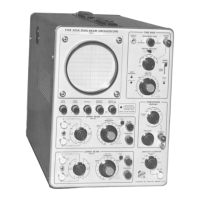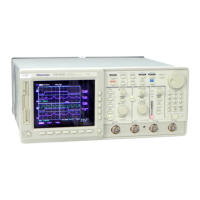Circuit Description— Type 544/RM544
for 216-244-volt operation). Thermal time-delay relay K600
provides a filament warmup time of approximately 30 sec
onds before the dc power supplies are activated. The heater
of K600 is rated at 6 volts and is connected to 6.3 volts on
the T601 secondary winding. During heater warmup time,
contacts 4 and 9 of relay K600 remain open. At the end of
heater warmup time, contacts 4 and 9 close and apply power
to magnetic relay K601. Contacts K601-1 of relay K601 re
move the heater power from K600, but before K600 can open,
contacts K601-1 lock the holding circuit to the coil of KdOl.
K601 now remains energized until the power to the oscillo
scope is switched off or otherwise interrupted. When K601
is energized, contacts K601-2, K601-3, K601-4, K601-5 and
K601-6 are also closed and thus activate their respective dc
supplies.
— 150-Volt Supply. The —150-volt supply in the Type 544
is the reference voltage source for the other supplies and
must be very stable. The —150-volt supply includes a high-
gain electronic voltage regulator designed to give good reg
ulation under extreme operating conditions. This regulator
circuit contains a series regulator, a glow-discharge tube ref
erence source, an error detector, and an amplifier.
In operation, the input power to the —150-volt suppl/ is
supplied by one secondary winding of T601. The ac output
of the secondary winding is rectified by silicon-diode recti
fier bridge D642 and filtered by capacitor C642A. In series
with the positive side of the supply and ground are series
regulator tubes V637 and V647, paralleled by shunting re
sistors R646 and R647. The output of the —150-volt supply
is taken from the negative side.
Error sensing in the voltage-regulator circuit is accom
plished by comparator tube V624. Current flow through V624
is established by the setting of the tap on R616 in the voltage
divider R615, R616, and R617. The voltage on the grid of
V624A is held at approximately —85 volts by reference tube
V609. Assuming that the output voltage of the —150-volt
supply increases due to increased line voltage of some other
cause, the voltage increase appears on the cathodes of V624
and, through the tap on R616, on the grid of V624B. Due- to
the voltage divider, only a part of the voltage increase ap
pears between the grid and cathode of V624B, but the full
change appears on the grid and cathode of V624A. The
increase is in the negative direction, therefore, V624A in
creases its conduction to maintain the proper bias between
qrid and cathode, and this holds both cathodes more or less
fixed while the grid of V624B is pulled negative by the in
creasing negative voltage across the voltage divider. The in
creasing negative voltage on the grid of V624B causes a de
crease in current; thus, the plate voltage goes positive.
The positive change in plate voltage is amplified and in
verted to a negative change by amplifier tube V634. The
amplified error signal from V634 is applied to the grids of
series regulator tubes V637 and V647. The negative-going
error signal on the grids of V637 and V647 decreases the cur
rent through the tubes, effectively increasing their resistance
and the voltage drop across them. The voltage necessary
to provide the increased drop across the series regulator
tubes and shunt resistors can only be obtained by subtracting
it from the negative side of the supply, so the undesired in
crease in negative voltage is absorbed in the series regula
tors and shunt resistors. If the output of the —150-volt
supply hod decreased instead of increased, then the error
voltage applied to the grids of the series regulators would
have been positive-going. The positive-going error voltage
on the grids of the series regulators would lower the resist
ance of the series regulator tubes, and the voltage drop
across them would decrease, leaving more voltage for the
negative side of the supply. Since the output voltage of the
—150-volt supply depends upon the relationship of the volt
age on the tap of R616 and the reference voltage from V609,
accurate adjustment of the output voltage is provided by
making R616 variable.
Filter capacitor C642A does not remove all the ripple from
the output of the bridge rectifier, thus the series regulator
circuit also helps to reduce this output ripple voltage. Any
ripple between the —150-volt output point and ground
reaches the grid (pin 2) of V624A via capacitor C610. This
input ripple voltage is amplified by V624 acting as a cathode-
coupled amplifier. The ripple output voltage at the plate (pin
6) of V624B has the same polarity as the ripple voltage at
the —150-volt output. C628 couples this ripple output volt
age to the grid of V634. The ripple voltage is further ampli
fied by V634 and applied to the grids of the series regulator
tubes with a polarity that opposes the original ripple voltage.
Ripple in the positive side of the —150-volt supply is coupled
into a degenerative feedback loop through R637 to the screen
of V634.
Some of the components in the —150-volt supply are not
necessary in normal operation but are included to insure
proper operation of the circuit under adverse conditions.
C636 provides for proper operation of the circuit when ex
tremely low temperatures reduce the capacitance of the
electrolytic filter capacitors. R640 and R641 protect against
large surge currents, and C642B suppresses sudden load
changes that fall outside the bandwidth of the regulator
circuit.
+ 100-Volt Supply. The input to the + 100-volt supply is
the output of secondary winding 19-20 of transformer T601
and silicon diode bridge D672. In addition to its other loads,
the -f 100-volt supply is required to supply current to a
series string of filaments at all times. When the Type 544 is
first turned on, relay K601 contacts are open and all the
regulated supplies are inoperative. During this time, the
series-string filaments are supplied by the unregulated side
of the -f 100-volt supply through relay contacts K601-4. By
the time relay K600 activates K601, the series-string filaments
have reached operating temperature. When K601 is acti
vated by K600, relay contacts K601-4 shift the series string
filaments to the regulated output of the + 100-volt supply.
The reference voltage source is the regulated output of the
—150-volt supply. V664A is the error amplifier, V664B com
pensates for V664A grid-cathode contact bias changes caused
by changing line voltage, and V677 is the series regulator
tube. The error-feedback circuit is through R650 and R651,
the junction of which is connected to the grid of V664A. The
top end of R650 is connected to the regulated + 100-volt
output, and the lower end of R651 is connected to the output
of the regulated —150-volt supply to obtain reference volt
age. With normal line voltages and loads, the voltage at
the junction of R650 and R651 is about —1.7 volts with ref
erence to ground; this is the operating bias of V664A.
If the load current, output voltage, or the input voltage
changes (including changes due to ripple), the output of the
regulated -f 100-volt supply starts to change also, but any
change appears across R650 and R651 and is applied to the
grid of V664A as a change in operating bias. Assuming that
3-3

